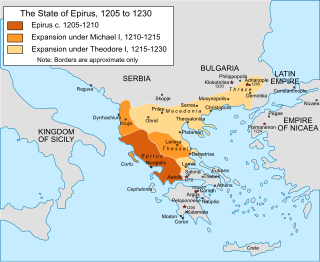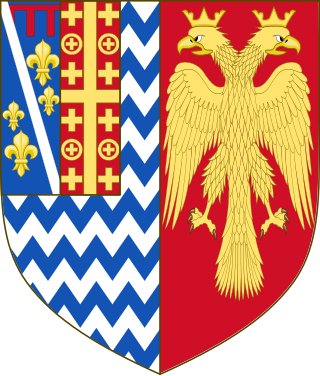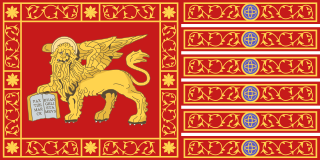Related Research Articles

The Despotate of Epirus was one of the Greek successor states of the Byzantine Empire established in the aftermath of the Fourth Crusade in 1204 by a branch of the Angelos dynasty. It claimed to be the legitimate successor of the Byzantine Empire, along with the Empire of Nicaea and the Empire of Trebizond, its rulers briefly proclaiming themselves as Emperors in 1227–1242. The term "Despotate of Epirus" is, like "Byzantine Empire" itself, a modern historiographic convention and not a name in use at the time.

The despot of Epirus was the ruler of the Despotate of Epirus, one of the successor states of the Byzantine Empire in the aftermath of the Fourth Crusade. The name "Despotate of Epirus" and the title "despot of Epirus" are modern historiographical names, and were not in use by the despots themselves. In the Byzantine Empire, the title of despot was a prestigious court title and did not designate rule over some specific territory. Though several of the early Greek rulers of the Epirote realm did use the title of despot, it was never in reference to the lands they governed, but instead in reference to their position in the imperial hierarchy.
Thamar Angelina Komnene was a princess consort of Taranto by marriage to Prince Philip I.
Nikephoros I Komnenos Doukas, Latinized as Nicephorus I Comnenus Ducas was ruler of Epirus from 1267/8 to his death in 1296/98.
Thomas I Komnenos Doukas ruler of Epirus from c. 1297 until his death in 1318.

Nicholas Orsini was a Greek–Italian nobleman who was count palatine of Cephalonia from 1317 to 1323 and ruler of southern Epirus around Arta from 1318 to 1323. The son of Count John I Orsini and an Epirote princess, he succeeded his father upon the latter's death, and in the next year murdered his uncle, Thomas Komnenos Doukas, and usurped his rule of Epirus. While able to secure his control over southern Epirus, however, the north with the city of Ioannina were taken over by the Byzantine Empire. Nicholas' attempts to ally with the Republic of Venice and recover Ioannina failed, and he was in turn killed by his brother John II Orsini in 1323.

John II Orsini, also John Komnenos Doukas or Comnenus Ducas, was count palatine of Cephalonia from 1323 to 1324 and Despot of Epirus from 1323 to 1335.
Carlo I Tocco was the hereditary Count palatine of Cephalonia and Zakynthos from 1376, and ruled as the Despot of Epirus from 1411 until his death on July 4, 1429.
Carlo II Tocco was the ruler of Epirus from 1429 until his death.
Leonardo III Tocco was the last ruler of the Despotate of Epirus, ruling from the death of his father Carlo II Tocco in 1448 to the despotate's fall to the Ottoman Empire in 1479. Leonardo was one of the last independent Latin rulers in Greece and the last to hold territories on the Greek mainland. After the fall of his realm, Leonardo fled to Italy and became a landowner and diplomat. He continued to claim his titles in exile until his death.

The County Palatine of Cephalonia and Zakynthos existed from 1185 to 1479 as part of the Kingdom of Sicily. The title and the right to rule the Ionian islands of Cephalonia and Zakynthos was originally given to Margaritus of Brindisi for his services to William II, King of Sicily, in 1185.
The counts of Gravina, later the dukes of Gravina, were medieval rulers of Gravina in Puglia, in the old Kingdom of Sicily and the Kingdom of Naples. The county was settled on various royal favorites, and was held by members of the Neapolitan royal family from about 1300 until 1385. In 1417, it was granted to Francesco Orsini, who was created a duke in 1436; his descendant holds the title today, and represents the remaining branch of the Orsini family. Among the Orsini dukes, Pietro Francesco resigned his temporal dignities in 1667 to become a Dominican, and subsequently ascended the papal throne as Pope Benedict XIII. His nephew, Duke Domenico II, was created cardinal. Francesco also achieved notoriety by being strangled while a captive of Cesare Borgia.

The House of Tocco was an Italian noble family from Benevento that came to prominence in the late 14th and 15th centuries, when they ruled various territories in western Greece as Counts Palatine of Cephalonia and Zakynthos and Despots of Epirus. During their brief period of rule in Greece, they were one of the most ambitious and able Latin dynasties in the region, and they were one of the few to leave descendants lasting until modern times.

Leonardo I Tocco was the count palatine of the islands of Cephalonia and Zakynthos from 1357 until his death, and later lord of Ithaca, Lefkada, and the port of Vonitsa as well.

The Ionian Islands were an overseas possession of the Republic of Venice from the mid-14th century until the late 18th century. The conquest of the islands took place gradually. The first to be acquired was Cythera and the neighboring islet of Anticythera, indirectly in 1238 and directly after 1363. In 1386 the Council of Corfu, which was the governing body of the island, voted to make Corfu a vassal of Venice. During the Venetian period the Council remained the most powerful institution on the island. A century later, Venice captured Zante in 1485, Cephalonia in 1500 and Ithaca in 1503. These 3 islands modelled their administration on Corfu's model and formed their own councils. The conquest was completed in 1718 with the capture of Lefkada. Each of the islands remained part of the Venetian Stato da Màr until Napoleon Bonaparte dissolved the Republic of Venice in 1797. The Ionian Islands are situated in the Ionian Sea, off the west coast of Greece. Cythera, the southernmost, is just off the southern tip of the Peloponnese and Corfu, the northernmost, is located at the entrance of the Adriatic Sea. It is believed that the Venetian period on the Ionian Islands was generally prosperous, especially compared with the coinciding Tourkokratia — Turkish rule over the remainder of present-day Greece.
Anna Palaiologina Kantakouzene was the niece of the Byzantine emperor Michael VIII Palaiologos, second wife of Nikephoros I Komnenos Doukas of Epirus and regent of Epirus upon his death around 1297.
Leonardo II Tocco was a scion of the Tocco family and lord of Zakynthos, who played an important role as a military leader for his brother, Carlo I Tocco, in early 15th-century western Greece.

Richard Orsini was the count palatine of Cephalonia and Zakynthos from before 1260 to his death in 1303/4, and also Count of Gravina in 1284–91. He also served on behalf of the Angevin Kingdom of Naples as captain-general of Corfu in 1286–90 and as the bailli in the Principality of Achaea from 1297 to 1300. He assisted the Despot of Epirus in battle against the Byzantine Empire, and secured the marriage of his son, John I, to the Epirote ruler's daughter, which would lead in 1318 to the Orsini takeover of Epirus.

John I Orsini was the count palatine of Cephalonia and Zakynthos from 1303 or 1304 to his death in 1317. Married to an Epirote princess, John spent a decade at the Epirote court before succeeding his father, Richard Orsini, as count palatine. As a vassal of the Principality of Achaea, he was involved in its domestic affairs and especially the dynastic dispute between the infante Ferdinand of Majorca and Princess Matilda of Hainaut in 1315–16, and participated in a number of Latin campaigns against Epirus, which he aspired to rule. A year after his death, his son and heir Nicholas Orsini seized Epirus and brought it under the Orsini family's rule.
Don Antonio Tocco was the last titular Despot of Epirus and Count Palatine of Cephalonia and Zakynthos, claiming these titles from the death of his father Leonardo V Tocco in 1641 until he abandoned them in 1642, substituting them for the title of Prince of Achaea, which he used until his death in 1678.